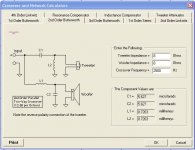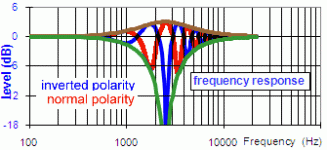I have got winspeakerz 2.5. When designing -12 db crossover it shows to reverse the tweeter polarity.
But it shows the same polarity in case mid speaker.
when -12 db, phase is -180 degrees, why not to change the polarity for mid speaker.
But it shows the same polarity in case mid speaker.
when -12 db, phase is -180 degrees, why not to change the polarity for mid speaker.
godfrey : There is no mid in that picture.
Here is the screenshot.
The woofer/mid do not ask to change polarity.
Either it is mid or woofer(as in the picture) doesn't make any difference.
The question is about connection polarity. Whether to reverse for woofer or not?
Hello,
If the coil-membrane junction of the 2 loudspeakers are vertically aligned then for a 2nd order Butterworth crossover (12dB*octave) you have to invert the polarity of the mid-high loudspeaker. It is the same with a 2nd order Linkwitz-Riley.
With perfect loudspeakers the Butterworth 2nd order gives theorically a +3dB bump in the frequency response and a flat response with the 2nd order Linkwitz-Riley.
If you use the Butterworth 2nd order,eventually you can move the mid-high loudspeakers forward on one inch (26millimeters) the response will be a bit better and the impulse response improved.
If you use a non inverted polarity for the mid-high loudspeaker then for both the 2nd order Butterworth and Linkwitz-Riley you'l have a deep hole in the frequency response around 2500Hz.
Best regards from Paris, France
Jean-Michel Le Cléac'h
If the coil-membrane junction of the 2 loudspeakers are vertically aligned then for a 2nd order Butterworth crossover (12dB*octave) you have to invert the polarity of the mid-high loudspeaker. It is the same with a 2nd order Linkwitz-Riley.
With perfect loudspeakers the Butterworth 2nd order gives theorically a +3dB bump in the frequency response and a flat response with the 2nd order Linkwitz-Riley.
If you use the Butterworth 2nd order,eventually you can move the mid-high loudspeakers forward on one inch (26millimeters) the response will be a bit better and the impulse response improved.
If you use a non inverted polarity for the mid-high loudspeaker then for both the 2nd order Butterworth and Linkwitz-Riley you'l have a deep hole in the frequency response around 2500Hz.
Best regards from Paris, France
Jean-Michel Le Cléac'h
Either it is mid or woofer(as in the picture) doesn't make any difference.
The question is about connection polarity. Whether to reverse for woofer or not?
Thanks Jmmlc,
I am going to use Butterworth filter.
For high i am going to use -24 db & for midwoofer -12 db.
This is going to be used in pro audio.
so normally with horns compression driver magnet will be behind magnet of midwoofer.
now tell me what to do?
I am going to use Butterworth filter.
For high i am going to use -24 db & for midwoofer -12 db.
This is going to be used in pro audio.
so normally with horns compression driver magnet will be behind magnet of midwoofer.
now tell me what to do?
Hello,
In the case of a large delay between the mid and the bass loudspeakers than the polarity of the mid has to be chosen on the basis of measurement or listening.
As an example if the acoustic source for the mid is at 8 inches ( around 20 centimeters) backward from the acoustic source fro the bass the best polarity for the mid is the normal. It leads to less rippling on the response curve.
See attached graph.
Best regards from Paris
Jean-Michel Le Cléac'h
In the case of a large delay between the mid and the bass loudspeakers than the polarity of the mid has to be chosen on the basis of measurement or listening.
As an example if the acoustic source for the mid is at 8 inches ( around 20 centimeters) backward from the acoustic source fro the bass the best polarity for the mid is the normal. It leads to less rippling on the response curve.
See attached graph.
Best regards from Paris
Jean-Michel Le Cléac'h
Thanks Jmmlc,
I am going to use Butterworth filter.
now tell me what to do?
Attachments
- Status
- Not open for further replies.
- Home
- Loudspeakers
- Multi-Way
- -12 out of phase for mid?

